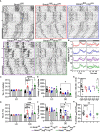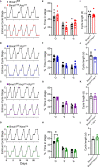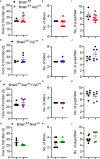Female fertility does not require Bmal1 in suprachiasmatic nucleus neurons expressing arginine vasopressin, vasoactive intestinal peptide, or neuromedin-S
- PMID: 35992114
- PMCID: PMC9389073
- DOI: 10.3389/fendo.2022.956169
Female fertility does not require Bmal1 in suprachiasmatic nucleus neurons expressing arginine vasopressin, vasoactive intestinal peptide, or neuromedin-S
Abstract
Disruptions to the circadian system alter reproductive capacity, particularly in females. Mice lacking the core circadian clock gene, Bmal1, are infertile and have evidence of neuroendocrine disruption including the absence of the preovulatory luteinizing hormone (LH) surge and enhanced responsiveness to exogenous kisspeptin. Here, we explore the role of Bmal1 in suprachiasmatic nucleus (SCN) neuron populations known to project to the neuroendocrine axis. We generated four mouse lines using Cre/Lox technology to create conditional deletion of Bmal1 in arginine vasopressin (Bmal1fl/fl:Avpcre ), vasoactive intestinal peptide (Bmal1fl/fl:Vipcre ), both (Bmal1fl/fl:Avpcre+Vipcre ), and neuromedin-s (Bmal1fl/fl:Nmscre ) neurons. We demonstrate that the loss of Bmal1 in these populations has substantial effects on home-cage circadian activity and temperature rhythms. Despite this, we found that female mice from these lines demonstrated normal estrus cycles, fecundity, kisspeptin responsiveness, and inducible LH surge. We found no evidence of reproductive disruption in constant darkness. Overall, our results indicate that while conditional Bmal1 knockout in AVP, VIP, or NMS neurons is sufficient to disrupted locomotor activity, this disruption is insufficient to recapitulate the neuroendocrine reproductive effects of the whole-body Bmal1 knockout.
Keywords: arginine vasopressin; circadian clock; fertility; luteinizing hormone surge; neuromedin-s; suprachiasmatic nucleus; vasoactive intestinal peptide.
Copyright © 2022 Tonsfeldt, Cui, Lee, Walbeek, Brusman, Jin, Mieda, Gorman and Mellon.
Conflict of interest statement
The authors declare that the research was conducted in the absence of any commercial or financial relationships that could be construed as a potential conflict of interest.
Figures






Similar articles
-
The transcription factor VAX1 in VIP neurons of the suprachiasmatic nucleus impacts circadian rhythm generation, depressive-like behavior, and the reproductive axis in a sex-specific manner in mice.Front Endocrinol (Lausanne). 2023 Dec 22;14:1269672. doi: 10.3389/fendo.2023.1269672. eCollection 2023. Front Endocrinol (Lausanne). 2023. PMID: 38205198 Free PMC article.
-
Circadian Function in Multiple Cell Types Is Necessary for Proper Timing of the Preovulatory LH Surge.J Biol Rhythms. 2019 Dec;34(6):622-633. doi: 10.1177/0748730419873511. Epub 2019 Sep 17. J Biol Rhythms. 2019. PMID: 31530063 Free PMC article.
-
Prenatal androgen treatment impairs the suprachiasmatic nucleus arginine-vasopressin to kisspeptin neuron circuit in female mice.Front Endocrinol (Lausanne). 2022 Aug 5;13:951344. doi: 10.3389/fendo.2022.951344. eCollection 2022. Front Endocrinol (Lausanne). 2022. PMID: 35992143 Free PMC article.
-
Vasopressin in circadian function of SCN.J Biosci. 2020;45:140. J Biosci. 2020. PMID: 33361631 Review.
-
An essential role for peptidergic signalling in the control of circadian rhythms in the suprachiasmatic nuclei.J Neuroendocrinol. 2003 Apr;15(4):335-8. doi: 10.1046/j.1365-2826.2003.01005.x. J Neuroendocrinol. 2003. PMID: 12622830 Review.
Cited by
-
In vivo recording of suprachiasmatic nucleus dynamics reveals a dominant role of arginine vasopressin neurons in circadian pacesetting.PLoS Biol. 2023 Aug 29;21(8):e3002281. doi: 10.1371/journal.pbio.3002281. eCollection 2023 Aug. PLoS Biol. 2023. PMID: 37643163 Free PMC article.
References
Publication types
MeSH terms
Substances
Grants and funding
- R01 HD100580/HD/NICHD NIH HHS/United States
- P42 ES010337/ES/NIEHS NIH HHS/United States
- P30 DK063491/DK/NIDDK NIH HHS/United States
- K99 NS119291/NS/NINDS NIH HHS/United States
- P30 CA023100/CA/NCI NIH HHS/United States
- F32 HD090837/HD/NICHD NIH HHS/United States
- R01 HD072754/HD/NICHD NIH HHS/United States
- R01 HD082567/HD/NICHD NIH HHS/United States
- T32 HD007203/HD/NICHD NIH HHS/United States
- P30 NS047101/NS/NINDS NIH HHS/United States
- P50 HD012303/HD/NICHD NIH HHS/United States
- R24 HD102061/HD/NICHD NIH HHS/United States
LinkOut - more resources
Full Text Sources
Molecular Biology Databases
Miscellaneous

